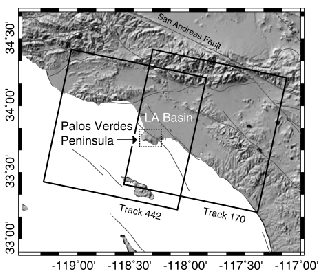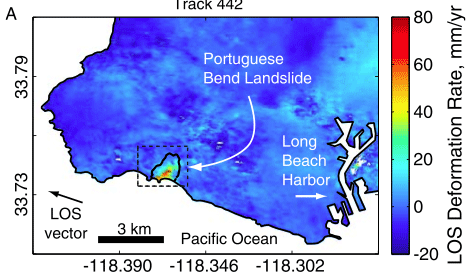Movement on the Portuguese Bend Landslide
Project Collaborators: Max Calabro, David Schmidt, Josh Roering (UO)
 The Portuguese Bend landslide, located on the Palos Verdes peninsula in southern California, is a slow‐moving landslide whose activity has greatly impacted the residential community. The landslide is part of a larger complex of slope failures with activity dating back more than 100,000 years. In 1956, the Portuguese Bend landslide was reactivated when construction crews began to dump large amounts of fill to flatten and extend a roadbed. In some areas they placed as much as 20 meters of fill, adding a significant load to the slope. Simultaneously, new housing developments in the area raised the water table through landscaping practices and newly installed septic systems. Since the initiation of the slide in 1956, deformation of the PBL has continued at rates varying with the seasons and rainfall levels.
The Portuguese Bend landslide, located on the Palos Verdes peninsula in southern California, is a slow‐moving landslide whose activity has greatly impacted the residential community. The landslide is part of a larger complex of slope failures with activity dating back more than 100,000 years. In 1956, the Portuguese Bend landslide was reactivated when construction crews began to dump large amounts of fill to flatten and extend a roadbed. In some areas they placed as much as 20 meters of fill, adding a significant load to the slope. Simultaneously, new housing developments in the area raised the water table through landscaping practices and newly installed septic systems. Since the initiation of the slide in 1956, deformation of the PBL has continued at rates varying with the seasons and rainfall levels.
We use radar interferometry to constrain the seasonal kinematics of the landslide from 1995 to 2000. We measure a mean summer deformation rate of 1.00 m/yr with a 1‐sigma uncertainty range of 0.39 to 2.57 m/yr based on a stack of 20 short-duration interferograms. In the winter, the slide accelerates beyond the measurable limit of the technique. Therefore, we focus on the coherence of the interferometric phase which decreases as the sliding rate increases. By mapping decorrelation through time, the spatial boundaries of the landslide are estimated and agree with the boundaries mapped in the field. Additionally, the timing of when the slide accelerates to velocities greater than 2.6 m/yr, as characterized by the steep phase gradient along the edges of the slide, is confined between the months of December and May. Combining this result with rain gauge data, the lag time between the onset of rainfall and the acceleration of the slide is determined to be about 1 month.
The results are fully documented in Calabro et al. (2010).

